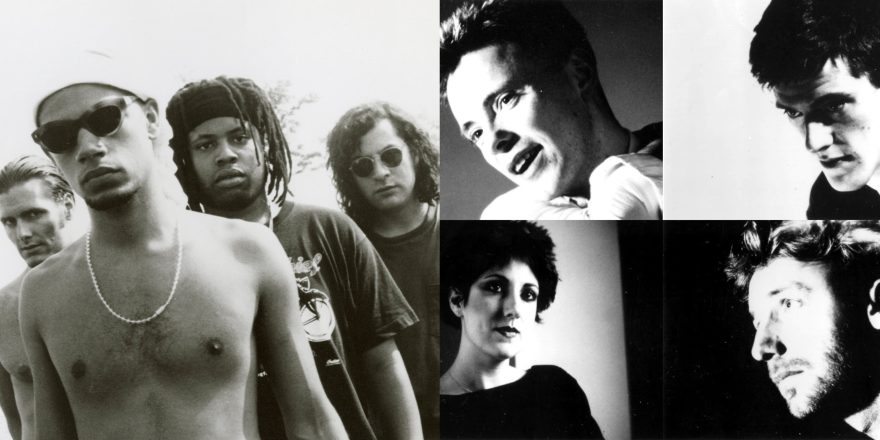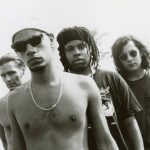I discovered Joy Division at the end of my first semester at the University of Michigan. It was December 1984, and finals week for me stretched out to the very last Friday before Christmas. I had taken an art history class, a detour from the normal freshman curriculum, so everybody had finished their finals while I waited out the week alone in my dorm room, studying less and listening to records more. The wreath on my door had dried out to become a bare circle of wire.
I don’t remember how I got the Closer album, but that week I learned why: With each listen, I was finding a voice and a voice was finding me. I didn’t know it was Joy Division’s second record, which I later realizes embraced the eerie newness of synthesizers and producer Martin Hannett’s masterful, atmospheric production more than Unknown Pleasures. The last three songs, “Twenty Four Hours,” “The Eternal,” and “Decades,” were especially cathartic, impossibly sad and anguished, like waking up from crying in a dream. Every tone seemed heightened, sensitized, and deeply affecting, more like seeing David Lynch’s The Elephant Man than listening to a band.
I found an uncanny comfort in the bass sound on “Twenty Four Hours.” The spongy, neon quality of Peter Hook’s line, so delicate but pronounced, like a call and response, resonated with me. The whole song seemed to wind around it, then chased Hook’s runs down the fretboard for the manic doubletime chorus. I don’t remember how I did on my Art History final, but I remembered that bassline.
A year later, I first heard “Love Will Tear Us Apart” at a dance club one Friday night, and proceeded to request it every week after. At the time, I was too busy dancing to it to want to figure out why.
Then in the summer of ‘87, I joined Spahn Ranch, a trio with percussion, choirboy vocals and droning guitar. They’d never had a bass player, and I certainly wasn’t one in any conventional sense. Like Hook — or “Hooky” as he was referred to in the British music press I was now poring over regularly — I favored melodies and chords on the higher strings. My one writing credit with Spahn Ranch, “Withering Rye,” was an homage to “Twenty Four Hours,” using the same spongy sound (a chorus pedal), the same runs, even the same double-time choruses.
As I got more and more into New Order, mostly from going to dance clubs in college, I heard Hooky creating even more indelible moments, beginning with “Ceremony,” with its elegiac, wistful riffs and bittersweet coda. Hooky’s line expressed a deep empathy, taking on a kind of emotional responsibility for the songs. When we started Majesty Crush in 1990, I was nowhere near as sophisticated with my bass playing, but I’d always come up with what we called a “window,” a little melodic phrase towards the end of a song, to create an emotional relief, even resolution. In just about every Majesty Crush song, from “Cicciolina” to “Boyfriend” to “Seine,” there’s something that tries to recreate that feeling I heard in the bass on “Twenty Four Hours.”
As I grew as a musician, I appreciated how Hooky’s compositions wove complete narratives. “Everything’s Gone Green” didn’t need a vocal; the bass was its voice. “Blue Monday” channelled Ennio Morrincone. “The Perfect Kiss” is perfect Hooky: He plays the melody higher and higher, ecstatically, before the line cascades down through three octaves, ending exhausted. I’d use the same plunging chord style for the final chorus of our “No. 1 Fan,” a song that has three basslines across two octaves. And why not? Hooky showed me the bass could be the poor band’s horn and string sections, not just the rhythm.
It wasn’t until I interviewed him for V Magazine in the summer of 2001 that I understood not just the how, but the why Hooky’s playing was so unique, and why I had such a visceral response to it. It was the last day of a press junket for New Order’s Get Ready album and I was driven outside Manchester to their rehearsal space, a garage behind Gillian Gilbert and Stephen Morris’s house, where they were preparing for Moby’s Area: One tour. Jet-lagged and manic with my video camera, I walked up to Hooky’s bass rig — the big burgundy Yamaha leaning against the rack-mounted wall of effects. He graciously turned it on and the sound was was orgasmic — that spongy neon I first heard on “Twenty Four Hours” 17 years earlier. He handed me the bass, I handed the camera to Stephen and began playing “Love Will Tear Us Apart” upside down and backwards. “Oh you’re left-handed,” Hooky said patiently, and then, as I continued, “It’s WRONG.” Defeated, I handed the bass back and he proceeded to play the same notes, but instead of just running up and down the G string strumming the open D like I did, he played the last two notes high on the D string, letting the G ring open. “You play it better than Hooky does,” Bernard Sumner joked. But at that moment, I understood. He had written “Love Will Tear Us Apart” that way so it DIDN’T sound too clean, too tied-up neatly with a bow on top.
What a revelation. It’s why in the middle eight of Unknown Pleasures’ “Disorder” he drops to an open E that yanks at the key of the song. It’s why, I learned during our interview, Joy Division, true to contrarian post-punk ideals, never made t-shirts. And as I learned from reading his three excellent books, why Hooky quit New Order when it became more a vehicle for Bernard’s admittedly great, but increasingly streamlined songwriting, than the collective efforts of their best years and songs.
Hooky didn’t always make things easy for himself but he always emerged, integrity intact, as a true original. And as much as in Majesty Crush, I too dressed and acted like a rocker with a soft spot for melody, and would also, tragically, see the untimely passing of our singer, I now feel an affinity for the man as much as his music. From overcoming addiction, healing relationships, surviving financial disasters and emerging a serene family man sharing his life and legacy with the world, Peter Hook is even more a role model — albeit one it’s taken me a lifetime to realize just how much I always had. 




